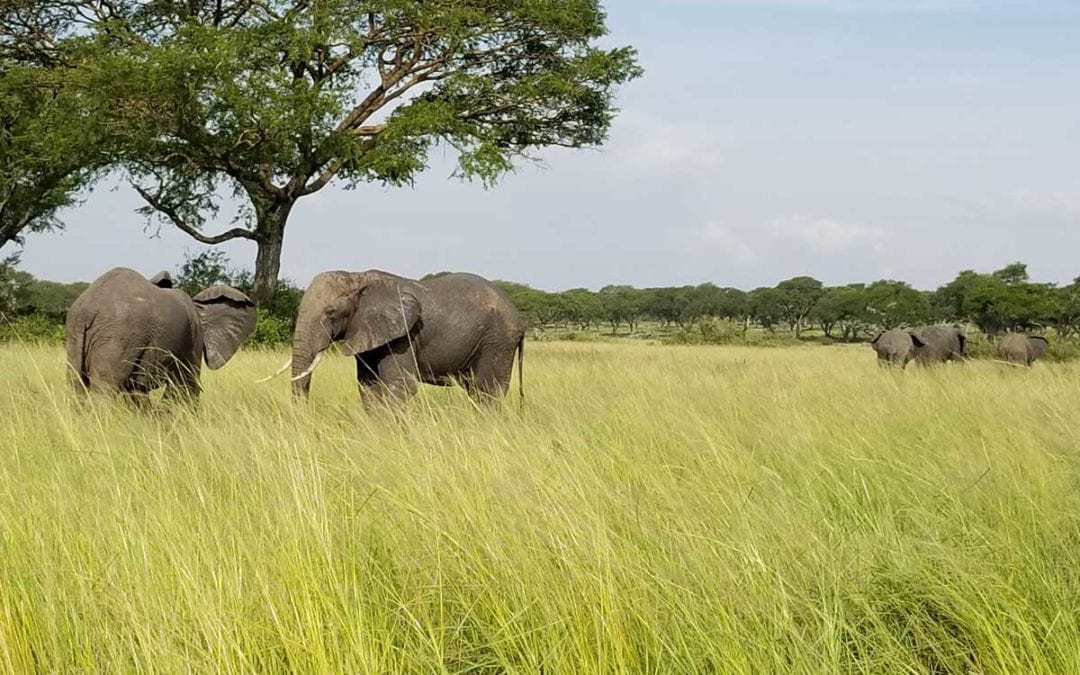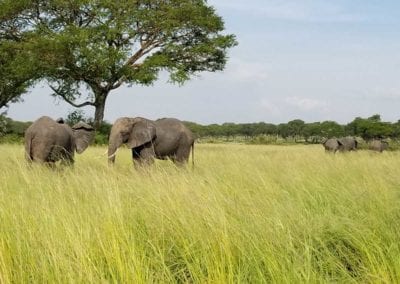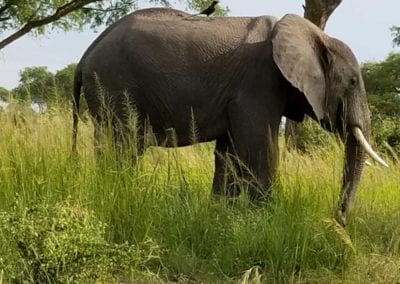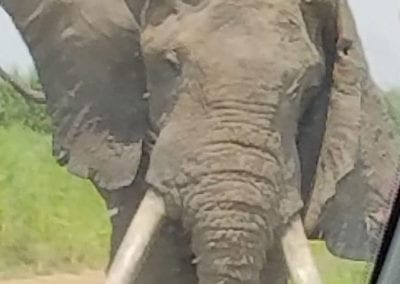He was the first elephant we saw. He was walking down the dirt path road, because it was easier than walking through the grass. I noticed he had a limp. Hassan stopped so we could take photos. We were very close.
We were headed on a safari after a week and a half of working in the severe poverty of Northern Uganda at The Big Fix veterinary hospital. It was a break that was needed. Ellie, the vet who talked me into this trip, and Barb, a physical therapist and client of Ellie’s, and I had worked hard emotionally and physically. Ellie had worked with a group she knew from her prior trip and had worked out all of the safari details. Including our own guide for the three of us. All I had to do was transfer a surprisingly small sum for food, shelter and our guide. Actually it was virtually the same amount that we saved by flying out on Tuesday instead of Sunday.
Isingoma Hassan Navid told us that his name was just Hassan. He was a young man who was caring for three of his younger siblings after his father had been injured and retired. He had gone to college to study wildlife and ecosystems to work as a guide. When he was six or seven, he saw his first tourists going to a safari. He went home and told his dad, he was going to go to school and get a job “driving white people around.”
That is what Hassan was doing when we saw The Old Guy. Right after the limp, I noticed the elephant’s left ear was damaged. There was a small hole about the size of a tusk at the top of the ear and a larger gash out of the bottom edge. Either there was nerve damage or the ear hurt too much to move, because the left ear didn’t move. Elephants flap their ears to help cool themselves. The large surface area of the ear allows the blood to cool before returning to the body. Remember Uganda is on the equator and the African sun was strong enough to burn the tops of my ears to the point of bleeding in less than an hour of exposure. Elephants also use their ears somewhat like cats and dogs do their tails. Ear flapping can mean either joy or aggression. The large ears help with long range hearing. Elephants also transmit sounds to their ears through the soles of their feet and their trunk. An elephant can easily hear another elephant’s call two and a half miles away. Under more ideal conditions, this could be up to six miles.
By the second or third elephant Barb leaned over to me and said “so, do you think the ears are big enough for these to be African elephants?” Recognizing it for the joke that it was, I said that I think that the ears didn’t really look like a map of Africa and maybe they were the smaller Asian elephant. We bickered back and forth for a bit when Hassan broke in that the African elephant is the largest land mammal at up to 4 meters and 7,500kg.
I was surprised to see that The Old Guy had both of his tusks and they were not broken. The tusks are modified incisor teeth and both males and females have them. Baby elephants are born with “baby tusks” which fall out after a year and are replace by permanent ones. Tusks grow throughout the elephant’s life. Tusks are used for digging, foraging, and fighting. Which explains the small hole in the top of this guy’s ear.
Tusks are also part of the illegal ivory trade. Increasing demand for ivory threatens elephants. Indeed this elephant did not carry his trunk quite right making me wonder about a poacher snare’s damage in one of my photos. A snare is a loop of wire that tightens around a foot or a trunk. We saw a few elephants who had raw snare damage to their highly sensitive trunks. The elephant would be caught by their trunk in the snare and would rip off the distal portion of their trunk in order to escape. The trunk is part nose and part upper lip and is prehensile meaning it is sensitive enough to grab things like our hands do. That must have been an amazing amount of pain to endue and still probably painful when they must use the shortened raw trunk to eat. I wanted to treat them.
Hassan told us that after mating, the male elephant would move out of the herd or to another herd. This guy was on his own until he could find another herd. The females stay with the herd and are pregnant for 22-months, but will only have a baby every five years. Everyone helps care for the newborn. Aunts, sisters, and cousins will gain practice before their own is born.
In the times between wildlife viewing, Hassan told us stories of that school and being caned for not learning his lessons. He told us of training to be a guide that included all the training to be a wildlife armed ranger. Apparently, he was very good at the weapons portion, but still didn’t like guns. Hassan not only learned about animals, but also plants and ecosystems.
When I asked about a strange tree with large grey fruit hanging from a vine, he said they were sausage trees. The fruits were inedible even toxic, but fermented when they fell to the ground. The elephants would sometimes seek out the grounded sausage fruits and eat them until they became drunk. I think there might a joke about a drunk three-ton elephant, but I know I don’t want to be in the way of a drunk elephant.
When the elephants eat fruits, the indigestible seeds are deposited with the huge dung pile that is basically fertilizer. Over ninety tree species rely on the elephant for propagation. Hassan pointed out a type of palm trees from Sudan that the elephants had carried in on there miles long treks. Those palms are considered invasive.
We saw many other elephant herds. In the female herd, there will be an older matriarch elephant with mothers and their young, sisters, and female cousins. When male elephants reach puberty at around 14 years old, they will leave the maternal herd. Males join a loose-knit band of other bull elephants, but leave whenever to search for potential mates.
Hassan achieved his goal and we found him to be a quite knowledgeable and pleasant guide. I think he liked us too. He took us to his gardens near the villiage where he grew up. We met his grandmother, who was out sweeping her compound when we arrived. At 89, she still lives alone, but the family did put a tin roof on the cooking shed so that she didn’t burn it down. An uncle came to check that we were not bothering her. Much like the elephant herds, I think she was the matriarch of her family.
I didn’t think about it at the time, but we were helping the elephants by our safari. Money goes directly to jobs for the lodges, rangers, and guides. We also boosting Africa’s economy through buying hand made items through the gift shops and local residents. This changes the actions of the villagers who have viewed elephants only as pests in the past.
I think about The Old Guy often. I wish I could have done something for his wounds or pain. I understand it is the way of the world, but it is a part, I don’t have to like. I hope he does well. (In the spirit of helping locally, I even commissioned a small print of him by a vet friend.) I chat with Hassan often also. I like that even after going to school and many tourists and safaris, he is still awed by The Old Guy enough to take photos and a video of him. Video that he shared when I asked about the damaged trunk.
Dr. MJ Wixsom owns and practices at Guardian Animal Medical Center on Bellefonte Road in Flatwoods, KY. 606.928.6566 and online at www.GuardianAnimal.com and has her fourth book out.




